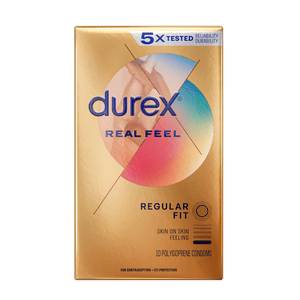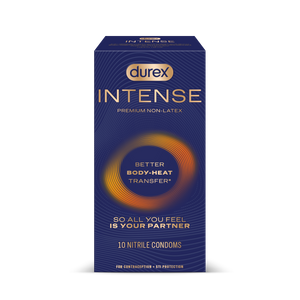Non-latex condoms
Looking for non-latex condoms? Our non-latex condoms are made from synthetic materials, such as nitrile or polyisoprene. No, we’d never heard of it before either, but our non-latex condoms are lubricated to provide maximum comfort and pleasure. At Durex, we don’t believe a latex allergy should interfere with your sex life.
What are non-latex condoms?
Non-latex condoms are an alternative to traditional latex condoms, they are made from synthetic materials. They were originally introduced because latex allergies are so common; about 4% of people in the general population are allergic to latex and just under 10% of healthcare workers have latex allergies!1 Non-latex condoms offer a safe alternative to protect against unwanted pregnancy and the transmission of STIs.
Types of non-latex condoms
Non-latex condoms come in a range of different materials. Let’s take a closer look at some of the best types of non-latex condoms.
Polyisoprene condoms
Polyisoprene is a type of rubber that’s fairly similar to latex with one significant difference. Whereas latex is a naturally occurring rubber, polyisoprene is made in a lab. That means it doesn’t contain the allergy-producing compounds that latex does, making it a safe alternative for those who are allergic.
Most people find that polyisoprene condoms feel quite similar to latex condoms, though they can be a little bit thicker. They offer a good amount of stretchiness and a smooth and comfortable feel.
Polyurethane condoms
Polyurethane condoms are made from a very thin and strong type of plastic. Just like latex and polyisoprene condoms, polyurethane condoms are effective at protecting against pregnancy and STIs when used correctly. While polyurethane condoms can be quite thin, they tend to have a bit less stretch than polyisoprene condoms and can fit a little looser.
Nitrile condoms
Nitrile condoms are the newest non-latex male condoms on the market. In fact, Durex Intense is the world’s first and only nitrile male condom. Like polyisoprene and polyurethane, nitrile is a synthetic rubber that doesn’t contain the allergens found in latex. Nitrile condoms are much thinner than latex condoms and allow for greater body heat transfer, resulting in a barely-there sensation.
Advantages of non-latex condoms
Latex allergies aren’t the only reason many opt for non-latex condoms. Let’s review the many advantages of a latex-free alternative.
Characteristics
While everyone has their own preferences, here are a few of the best characteristics of non-latex condoms:
- Better body heat transfer: Nitrile condoms offer much better body heat transfer than latex condoms—so all you feel is your partner.
- Thinner: Nitrile and polyurethane condoms tend to be much thinner than latex condoms. This allows for greater sensation and a closer feeling of intimacy.
- Greater moldability: Nitrile condoms also mold to your body for a tighter, more secure, and more comfortable fit.
- Odorless: While latex condoms tend to have a rubber smell, nitrile non-latex condoms are odorless.
Frequently Asked Questions
Nitrile and polyisoprene condoms are as strong as latex condoms, with plenty of stretch and a moldable and comfortable fit. Polyurethane condoms, on the other hand, are much less stretchy and may have a looser fit. Because of this, they tend to slip and break more often than latex condoms and other types of non-latex condoms.
The type of lube you can use with a non-latex condom depends on its material. All non-latex condoms are compatible with silicone-based lubes. Polyurethane and polyisoprene condoms are compatible with water-based lubes.
Before using a new condom or new lube, be sure to check the package instructions for compatibility.


